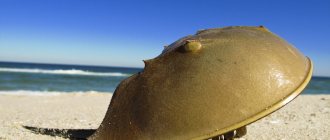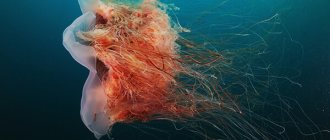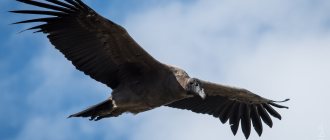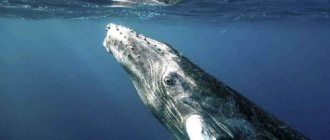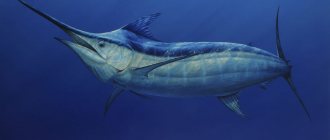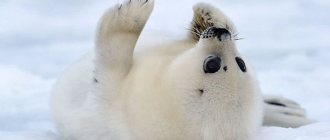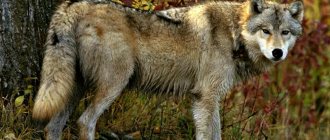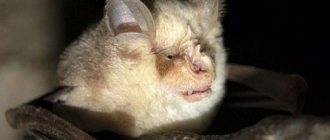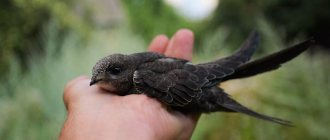30.11.2016
The Arctic is the region located around the North Pole. There are polar days and nights, winters are very cold, and summer temperatures do not rise above zero degrees. But for many creatures, such extreme conditions are only a plus. What animals live in the Arctic. We offer you descriptions and photographs of the most interesting animals of the Arctic.
Carnivorous mammals of the Arctic
Most Arctic predators are ferocious hunters with good appetites that can attack livestock and even people. The number of individuals in the population of Arctic predators depends primarily on the number of lemmings, which are the main “delicacy” for arctic foxes, wolverines, polar wolves, and in some cases, reindeer.
Polar bear
The largest representative of the Bear family, listed in the Red Book of the World back in 1953, is not found anywhere except the Arctic. To live, he needs clearings of drifting ice, ice holes or the edge of ice fields, and seals - his favorite food.
The closest recorded polar bear habitat to the pole has a latitude of 88°15′. Some male polar bears reach three meters in height and weigh a ton. But with such an impressive size and apparent clumsiness, polar bears are extremely mobile and hardy animals.
Polar bears are excellent swimmers, covering up to 80 km in icy waters, thanks to the membrane on their paw pads. Polar bears easily travel about 40 km per day, coping with difficult ice ridges and deep snow. Polar bear fur retains heat so well that even aerial infrared imaging cannot detect it.
Wolverine
A large representative of the Mustelidae family, a ferocious predator and an extremely voracious animal. Due to the ability of this animal to attack livestock and even people, it is also called the Demon of the North. The weight of wolverines varies from 9 to 30 kg, and in appearance they are more similar to badgers or bears.
Unlike other representatives of the Mustelidae family, the wolverine migrates within its individual territory, constantly searching for food. The animal easily climbs trees thanks to its sharp claws and powerful paws. It makes sounds similar to the yelps of dogs and has excellent hearing, vision and sense of smell.
The wolverine is omnivorous, it can either eat leftover food from other predators or hunt on its own even quite large animals; it also eats plants - berries, nuts. This is such a brave and vicious animal that even the owner of the Arctic, the Polar Bear, tries to avoid it when meeting it.
polar Wolf
This subspecies of wolf lives throughout the tundra and Arctic. It usually feeds on small animals - arctic hares and lemmings, but musk ox and reindeer are also part of its diet. In the harsh conditions of polar nights and long cold periods, he adapted to feeding on any food.
Polar wolves can only survive in a pack. In the Arctic deserts, where there is no place for an ambush, they have to resort to another - social hunting tactics, often patiently waiting for the victims to make a mistake and weaken their defenses.
Arctic fox, or arctic fox
The polar or arctic fox is a predatory animal, the only representative of the Arctic fox genus. Unlike the common fox, it has a shortened muzzle, small rounded ears, paws covered with coarse hair and a squat body. Depending on the season, the fur of the Arctic fox can be white, blue, brown, dark gray, light coffee or sand. Based on this characteristic, 10 subspecies of animals are distinguished that live in different territories.
No further than half a kilometer from the water, the arctic fox digs complex burrows with numerous entrances. But in winter, he often has to make do with a den in the snow. He eats everything; his diet includes both plants and animals. But the basis of its diet are birds and lemmings.
Arctic desert climate
The harsh climate contributes to the formation of ice and snow covers that persist throughout the year. The average temperature in winter is -30 degrees, the maximum can reach -60 degrees.
Due to the harsh climatic conditions, the Arctic desert is home to a small number of animals and virtually no vegetation. This natural area is characterized by strong hurricane winds and blizzards. Even in summer, desert regions receive minimal light, and the soil never has time to fully thaw. During the “hot” season, the temperature rises to zero degrees. As a rule, the desert is cloudy and often rains and snows. Due to the strong evaporation of water from the ocean, the formation of fogs is observed.
The Arctic desert is adjacent to the North Pole of the planet and is located above 75 degrees north latitude. Its area is 100 thousand km². The surface occupies part of the territory of Greenland, the North Pole, and some islands where people live and animals live. Mountains, flat areas, glaciers are components of the Arctic desert. They can be of different shapes and sizes, and have a distinct patterned structure.
Ungulate mammals of the Arctic
The plant populations of the Arctic provide for the existence of large groups of large herbivorous ungulates. Their numbers are subject to strong changes due to long cold periods. An adaptation to this is their migration to forest areas located to the south.
Reindeer
Animals evolve the faster the more complex the conditions of their existence. Reindeer are so different from other representatives of the Deer family that it immediately becomes clear that they are okay with difficulties. Caribou (as they are called in North America) are not only champions of survival, but also the youngest members of the family. They appeared only about two million years ago.
The flat and wide hooves of reindeer, pointed at the edges, turn the animals into all-terrain vehicles. They travel through snow, swamps and ice with ease. These same hooves, used instead of flippers, help deer to swim perfectly and overcome not only large rivers such as the Yenisei, but also sea straits. Their fur has a special structure; its hairs expand towards the end and create a heat-insulating air layer. Even their upper lip and nose are covered with delicate, soft hair.
Reindeer eat a variety of food - in summer it is succulent plants, in winter - lichens and shrubs. To compensate for the lack of microelements, they gnaw on their own discarded antlers and eat algae and shells washed ashore. An important reason for their survival is their herd lifestyle.
Muskox
A rare powerful hoofed animal, the same age as the mammoth, with a thick undercoat that is several times warmer than that of a lamb. Their long, thick hair hangs from above almost to the ground and covers the animal, leaving only the hooves, horns, nose and lips outside. Musk oxen survive the winter cold without migrating; they easily tolerate severe frosts, but die in the presence of high snow cover, especially with an ice crust on top.
Meaning for humans
In recent years, the Arctic desert has experienced an increase in tourism. Visitors to the cold desert come here for the unique ecosystem and stunning snowy landscapes. Lakes, rivers, streams and mountains provide additional leisure activities for tourists from all over the world. Some recreational activities include cruising, boating, sport fishing, mountaineering, hunting excursions, rafting, hiking, dog sledding, skiing, snowshoeing, and more. The never-setting sun during the Arctic summer is another reason for the interest of tourists who visit the Arctic desert for this surreal phenomenon. Visitors also gain experience of Inuit culture and life by visiting their settlements. The Arctic desert, being the polar region of the planet, plays a key role in regulating the Earth's climate.
Pinniped mammals of the Arctic
Their nostrils are large enough to allow them to inhale enough air to stay underwater for up to 10 minutes. Their forelimbs are transformed into flippers, and their food is marine life - mollusks, krill, fish, crustaceans. Let's introduce the most common pinnipeds of the Arctic.
Walrus
The only modern representative of the Walrus family is easily distinguishable thanks to its massive tusks. In terms of size, it ranks second among pinnipeds after the elephant seal, but the ranges of these animals do not overlap. Walruses live in herds and bravely protect each other from enemies.
Seal
They have a wider distribution and live along the shores of the Pacific, Atlantic and Arctic oceans. They are very good swimmers, although they cannot be found far from the shore. Seals do not freeze in cold water thanks to a thick layer of subcutaneous fat and waterproof fur.
Fur seal
Fur seals, together with sea lions, belong to the family of eared seals. When moving, seals rely on all their limbs, and their eyes have a dark outline. In summer, the Northern fur seal lives in the north Pacific Ocean, and with the arrival of autumn it migrates to the south.
Northern elephant seal
It should be noted here that elephant seals are divided into northern (living in the Arctic) and southern (living in the Antarctic). Elephant seals got their name because of the impressive size and trunk-like nose of old males. They live on the Arctic coast of North America and even further south. Adult males reach a mass of 3.5 tons.
Environmental threats
The human population in the natural zone of the Arctic desert and adjacent areas is quite low. The most pronounced threat comes from mineral exploration and extraction. Global warming also has a negative impact on the Arctic desert environment, upsetting the delicate balance of this ecosystem. As the planet's temperature rises, permafrost heats and melts, releasing carbon from the soil into the atmosphere, accelerating climate change. Global warming is melting the polar ice caps, causing sea levels to rise and increasing the threat of flooding to the planet's coastal regions. Melting ice caps also threaten polar bears. They need ice for hunting, and melting ice reduces and fragments their hunting grounds. Additionally, orphaned cubs have even lower survival rates because they are left to fend for themselves.
Marine mammals of the Arctic
No other mammal has the ability to survive the harsh conditions of the Arctic with cetaceans such as the beluga whale, narwhal and bowhead whale. They do not have the dorsal fin present in other cetaceans. The Arctic is home to about 10 species of marine mammals - whales (fin whales, blue whales, humpbacks and sperm whales) and dolphins (killer whales). Let's talk about the most popular of them.
Narwhal
They are distinguished by the presence of only two upper teeth, of which the left one in males develops into a tusk up to 3 meters long and weighing up to 10 kg. With this tusk, males break the ice, making holes; it also serves to attract females and many other purposes.
Belukha
This is a species of toothed whale from the Narwhal family. Beluga whales also require atmospheric oxygen and risk suffocation if trapped under solid ice for long periods of time. They feed on fish and make a variety of sounds.
bowhead whale
This is the only representative of baleen whales that lives its entire life within the cold waters of the Northern Hemisphere. In the spring they migrate north, and in the fall they sail a little south, avoiding the ice. They feed on plankton.
Killer whale (killer whale)
The killer whale is the largest predatory dolphin. Its color is contrasting - black and white with distinctive white spots above the eyes. Another original feature of killer whales is their tall, sickle-shaped dorsal fin. Different populations of these predators specialize in certain food. Some killer whales prefer herring and migrate after their schools, others hunt pinnipeds. They have no rivals and are the top of the food chain.
Arctic deserts of Russia
The southern border of the Russian Arctic desert is about. Wrangel, northern - about. Franz Josef Land. The zone includes the northern edge of the Taimyr Peninsula, about. Novaya Zemlya, New Siberian Islands, seas located between land areas. Despite the harsh nature in this area, the picture truly looks fabulous and bewitching: vast glaciers stretch around, and the surface is covered with snow all year round. Several times a year the air temperature rises to 0-+5 degrees. Precipitation falls in the form of frost, snow, frost (no more than 400 mm). This area is characterized by strong winds, fog, and cloudiness.
In total, the area of the Arctic deserts of Russia is 56 thousand km². As a result of the movement of continental ice onto the coast and their frequent washing with water, icebergs form. The share of glaciers ranges from 29.6 to 85.1%.
Characteristics
An Arctic desert is a barren land of permafrost covered by glaciers over 55,000 square meters. km. The average ice thickness is 2 m. In summer the temperature does not exceed plus 5 degrees, and in winter it drops to 50, there is little precipitation.
arctic desert photo
The vegetation, extremely sparse and sparse, is represented by mosses, lichens and herbs. There are few lakes in the areas occupied by the ice desert. The subsoil of the Arctic (Arctic is translated as bear) contains undeveloped reserves of energy resources - oil and gas. The territory of the Arctic desert has not been sufficiently explored.
↑ Interesting facts
- In order to distinguish between equipment and buildings on the white snow, bright orange paint is chosen for painting. Workers' clothing is made from bright blue and bright red fabrics.
- Yayu, the western island belonging to the New Siberian Islands, was discovered in September 2013.
- In 1930 Vasilievsky Island, which existed here, disappeared. It turned into a sandbank as a result of melting ice.
- In 2015, an Arctic expedition discovered 9 islands of the Novaya Zemlya archipelago. This increased the territory of Russia by 10 sq. km, and the length of the continental shelf by 370 km.
Natural resources of the Arctic desert
Despite the unfavorable living conditions, the Arctic desert is quite attractive for mining. The main natural resources are oil and gas. In addition, in snowy areas you can find fresh water, catch valuable species of fish and extract other minerals. Unique, untouched, mesmerizing glaciers attract thousands of tourists, bringing additional economic benefits.
The Arctic regions also have deposits of copper, nickel, mercury, tin, tungsten, platinum group metals and rare earth elements. In the desert you can find reserves of precious metals (silver and gold).
The biodiversity of this region largely depends on humans. Violation of the natural habitat of animals, or the slightest change in soil cover can lead to serious consequences. Today, the Arctic is one of the main sources of fresh water, as it contains up to 20% of the world's supply.
Soils
Photo of the soil in the Arctic desert in summer
Due to the temperature characteristics of the Arctic deserts, the soil is in a frozen state most of the time, almost the entire year. This makes it very difficult for water to drain. Permafrost has high values - 600-1000 meters. At low temperatures, you can observe lakes on the soil from melt water. In addition, there is a spread of rubble and other rocks throughout the territory due to the constant movement of glaciers. The soil of the Arctic zones has a thin horizon, is poor in nutrients and contains a large amount of sand.
Interesting fact : in areas with elevated temperatures, the presence of organic materials is determined that help the growth of certain fungi, moss, and algae. Such soils are called brown.
Tourism
In the Arctic zone there is the Russian Arctic National Park (the northern part of the Novaya Zemlya archipelago, created in 2009). In 2016, it included the territory of the federal nature reserve “Franz Josef Land” (created in 1994). In addition, there is a state reserve on Wrangel Island, included in the list of UNESCO World Natural Heritage sites. In the summer months, 10-20 cruise tours are carried out annually to the Arctic, in particular, on the Russian nuclear icebreaker “50 Let Pobedy”. The total number of tourists is about 2 thousand people.
On April 2, 2022, the State Duma of the Russian Federation adopted a bill in the first reading that allows foreign tourists to land on shore in a number of ports in the Arctic and Far East for sightseeing. According to Deputy Minister of Economic Development of the Russian Federation Sergei Galkin, this measure will increase the flow of tourists in the Russian part of the Arctic by two to three times.
Peoples and cultures
Photos of the Inuit
The Arctic deserts are inhabited by people such as the Inuit (Eskimos). They have completely adapted their lives to the conditions of year-round cold and permafrost. Since people do not have building materials, they build ice houses - igloos. If they begin to melt in the summer, the Eskimos move into tents before the onset of frost. The Inuit eat meat and fish, since they do not have conditions for growing vegetables and grain crops. They travel on sleighs with sleds using dogs.
Interesting: Steppe - Description, features, types, location, soils, climate, flora, fauna, photos and videos
Eskimo communities are located in different parts of the Arctic desert. They may be called differently in each country. However, regardless of their territorial location, they all speak the same language and have common traditions and way of life.
Plants
Arctic desert plants
Arctic desert plants
Arctic desert plants
Arctic desert plants
Arctic desert plants
Arctic deserts are considered harsh for the existence of animals, plants and, of course, people. Getting food, getting nutrients, and providing living conditions are difficult tasks in permanently frozen conditions. However, despite this, the Arctic involves an area that is densely covered with vegetation. It occupies almost half of the desert. There are no trees or shrubs in such areas, but moss, lichen, and algae grow well on rocky soil.
Interesting fact : In the desert you can find pike, buttercup, saxifrage, polar poppy and other plant species that are not always found in milder climates.

